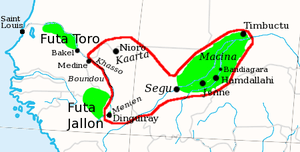Toucouleur Empire
| Toucouleur Empire | |||||
| Tidjaniya Caliphate | |||||
| |||||
 the greatest extent of the Toucouleur Empire at the time of El Hadj Umar Tall's death in 1864 | |||||
| Capital | Segou | ||||
| Languages | Fula | ||||
| Religion | Sunni Islam | ||||
| Government | Monarchy | ||||
| Caliph | Umar Tall | ||||
| History | |||||
| - | Established | 1848 | |||
| - | Disestablished | 1890 | |||

The Toucouleur Empire (also known as the Tijaniyya Jihad state or the Segu Tukulor) (1861-1890) was founded in the mid-nineteenth century by El Hadj Umar Tall of the Toucouleur people, in part of present-day Mali.
Umar Tall returned from the Hajj in 1836 with the titles of El Hadj and caliph of the Tijaniyya brotherhood of the Sudan. After a long stay in Fouta-Toro (present day Senegal), he moved to Dinguiraye (to the east of Fouta Djallon in present-day Guinea). This became the staging ground for his 1850 jihad.
Abandoning his assault on the French colonial army after an 1857 failure to conquer Medina fort, Umar Tall struck out against the Bamana Empire with much greater success - first Kaarta and then Segou.[1] Following a decisive victory in the Battle of Segou on March 10, 1861, he made Segou the capital of his empire. A year later he left its management to his son Ahmadu Tall to move against Hamdullahi, the capital of the Fula empire of Massina. Umar Tall failed to conquer Timbuktu, and retreated to Deguembéré, near Bandiagara of the Dogon region. In 1864, he died there in an explosion of his gunpowder reserves.
His nephew Tidiani Tall succeeded him and installed the capital of the Toucouleur Empire at Bandiagara. At Segou, the son Ahmadu Tall continued to reign, successfully suppressing the attempts of several neighboring cities to break away. He came into increasing conflict with his brothers.
In 1890, the French, allied with the Bambara, entered Ségou. Ahmadu Tall fled to Sokoto in present-day Nigeria, marking the effective end of the empire.
See also
References
- ↑ "Umar Tall", African Legends
Further reading
- Davidson, Basil. Africa in History. New York: Simon & Schuster, 1995.
- Klien, Martin. Slavery and Colonial Rule in French West Africa. Cambridge University Press, 1998. ISBN 0-521-59678-5
- Oloruntimeehin, B.O. The Segu Tukulor Empire. New York: Humanities Press, 1972. ISBN 391002066
- Roberts, Richard L. Warriors, Merchants. and Slaves: The State and the Economy in the Middle Niger Valley, 1700-1914, Stanford University Press, 1987. ISBN 0-8047-1378-2